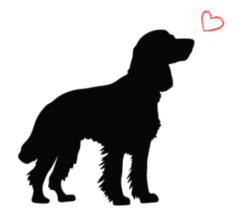We would like to think so
We would notice a limp, a yelp, crying or groaning when moving. We may notice our dogs not getting up or laying down so easily
However, we may also note our dogs not wanting to jump in and out of the car or perhaps travel unsettles them. Not only can the impact of jumping aggravate their joints but the micro vibrations of the car can be uncomfortable
Ever been in pain and wanted the driver to slow down and be more careful or if driving felt uncomfortable like you hit every bump in the road? Our dogs may freeze on walks and appear stubborn not wanting to go home but actually not want to go in the car
We may note a change in the way our dog lays or sits. Perhaps their former ‘square’ sit has become sloppy, or you noticed they like to have their head supported when they rest. Perhaps their walk has changed, and their head carriage is lower, they pull or push themselves along. Maybe they throw themselves up or down to lay no longer a spritely move Perhaps they avoid doing particular behaviours and no longer want to engage in tricks or agility. Maybe they actively avoid certain surfaces like slippery floors, wet mud or even stairs
We take many pictures and videos of our dogs This give up lots of opportunity for comparison. We could compare these to see small changes that may not be so obvious
We may also spot behavioural changes, perhaps our dog solicits contact only then to be snappy or growls They used to cuddle up on the sofa but now growl at you as you sit next to them or get up and move away, again the discomfort or vibrations may cause them pain. Perhaps they pant at rest when it’s not particularly hot Perhaps your dog has gradually become more intolerant of people or other dogs. Not enjoying interactions, becoming withdrawn or even becoming defensive on approach. If you were sore would you like someone to run up to you? Would bracing or moving exacerbate discomfort
But your dog still gets excited for walks! They still want to run and play…..well yes they do. Sometimes from habit, to please their humans but adrenalin is a great painkiller.
Ever wandered where that bruise came from? Fallen over and quickly got up and moved on to cover it up but actually later realised you are injured, wanted to go out with friends or not miss an event only to feel fine while out but you really aren’t when you get home!
We also need to consider that everyone and dogs have different pain thresholds. What is agony for one person may not bother another. When you have chronic pain, a small bump may set off alarm bells to your body and feel extremely painful We may also see an increase in noise sensitivity. Again, have you noticed everything seems louder when you don’t feel well. Imagine feeling uncomfortable then a noise makes you jump exacerbating your pain Perhaps you’ve noticed signs of separation anxiety starting, or hiding, avoidance, clinginess or even not being able to settle due to not being able to get comfortable
Your dog may run away from their harness to avoid going out or because it presses where it hurts Perhaps you’ve noticed chewing, licking or constant nibbling, bald patches that give us a clue. Maybe they have started to show abnormal repetitive behaviours such as tail chasing, light/reflection chasing
Our dogs whatever age deserve to be heard. They give us so many clues. It’s one of the reasons I became a Dynamic Dog Practitioner.
Some behaviours or actions such as the terrier skip or hop get ignored as ‘normal’ as they are common. However, just because they are common doesn’t mean they should be considered normal
First port of call should be your vet for any behaviour changes. Pictures and videos for comparison are so useful as most of our dogs can get stressed at the vets, whether that’s terrified, shut down and not responsive or over excited this all triggers adrenalin.
You could also reach out to a qualified Veterinary Physiotherapist for support
Have you spotted any of these in your dogs? Canine Arthritis Management have a free course to help identify pain in your dog:
https://www.cameducation.co.uk/course/is-my-dog-in-pain
Pictures below of Caleb with his raised head, odd sternal sleep position and low head carriage careful walk. Tilly who self-mutilated her thigh as a cry for help.
Amanda,
Team Tilly Canine Coaching

